These last two episodes of The Rings of Power sure did some things, didn’t they? Have they changed my overall opinion of the show? Only a little, because I’m still compartmentalizing this thing. Have episodes 4 and 5 made my trust in the showrunners waver somewhat? Yes. Do I retain hope that the show will “survive” this recent stumble, and go on to still be excellent overall? Yes, I’ve still got some hope. But it’s Amdir hope, not Estel hope. I’ll explain.
So here follows another opinion-riddled discussion of the last two episodes, filled to the brim with spoilers.
So what’s Amdir? That’s a term that comes up in the Athrabeth Finrod ah Andreth (the “The Debate of Finrod and Andreth” from Morgoth’s Ring). Sometime during the First Age, during a time of relative peace, Andreth, a wise-woman of Men, is speaking to her friend Finrod—who is truly not the Rings of Power take on Finrod, but Tolkien’s truer and more righteous one. Going forward, when I slap the adjective RoPer on something, I’m referring very specifically to the Rings of Power version of that thing. For example, Gil-galad from Appendix B of The Lord of the Rings “refuses to treat with Sauron” when Sauron attempts to seduce the Elves in 1200 of the Second Age. Whereas RoPer Gil-galad has strange hair and is built like an Elf-quarterback.
Anyway, Finrod and Andreth are discussing death and the very different dooms of Elves and mortal Men. At one point, she begins to despair, and points out to him that only darkness lies ahead for mortals.
‘Have ye then no hope?’ said Finrod.
‘What is hope?’ she said. ‘An expectation of good, which though uncertain has some foundation in what is known? Then we have none.’
‘That is one thing that Men call “hope”,’ said Finrod. ‘Amdir we call it, “looking up”.
There are two varieties of hope, Finrod goes on to explain. Amdir is a kind of realistic hope rooted in precedent, expectation, or experience. It’s a reasonable hope, however slim, based on something substantial. Because The Rings of Power has had some excellent plot threads, characterizations, and themes that are both moving and complementary of Tolkien’s work, I will trust that the show will succeed in the most important ways in the days to come. Elrond’s friendship with Durin; Disa herself; Nori, Poppy, and the Stranger; Arondir and Bronwyn . . . these are characters and storylines I really enjoy even though I don’t know where they’re all going. So when the show missteps, as it has in episode 5, I maintain Amdir that it will still retain a faithful heart because it’s still got a lot going for it.
What I do not have at this time is Estel, hope that springs from something greater; hope that trusts that in the end a truly outstanding depiction of Middle-earth will prevail because it must, because a greater power lies above and will ensure that all comes to right. I think showrunners Payne and McKay have the best of intentions, but those who pay them, of course, mostly just want to profit.
So yes, I’d like to talk about the precarious corner into which the show has painted itself, and then I’ll offer some comments on other elements. But part of my Amdir, “looking up,” is thinking that all choices the writers have made have at least been deliberate. I don’t think it’s ignorance of the source material that we’re seeing in episode 5. It’s going somewhere, and we’ve still only seen five out of fifty episodes. This can’t be the whole situation with the Elves.
Anyway, let’s get to it. Starting with a quick refresher on the major plot lines…
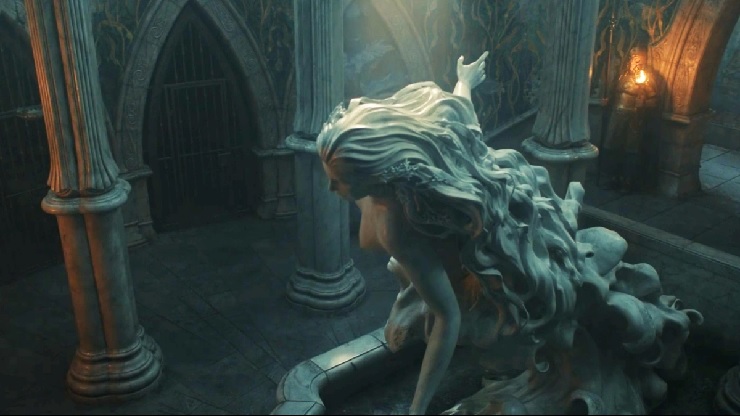
Episode 4, “The Great Wave” — Queen Regent Míriel has a terrible dream. Then, as some of the Númenóreans are disgruntled about Galadriel and Halbrand’s shenanigans, Pharazôn gives an “impromptu” political speech in a city plaza, stoking the discontent of the Elf-hating majority. Galadriel tells Míriel what she really wants (for Númenor to ally with Elves once more and seek out Sauron), but she crosses a line and ends up in jail along with Halbrand (and the prison’s permanent occupant, that statue of Uinen). Isildur, further inspired by a mysterious voice to be somewhere else, gets himself kicked off the Sea Guard along with two of his friends; not only are they pissed, we learn that Isildur’s brother (Anárion) used to spew “garbage” about the real Númenor over on the western shores of the island and they’re mad at him for that talk, too.
Over in the Southlands, Arondir has a disturbing chat with the “lord-father” of the Orcs, Adar; Arondir is then released on the condition that he deliver Adar’s ultimatum to the refugees from Tirharad. Meanwhile, Theo goes in search of food for his people, armed only with that evil sword-hilt he’s been carrying around; this leads to getting hunted by orcs—who, it turns out, have been searching for the sword-hilt all along. Elrond and Celebrimbor chat while the Elves of Eregion and the Dwarves of Khazad-dûm are working on the new forge-tower (with lovely Elvish scaffolding!). Celebrimbor brings up Elrond’s father, suggesting that Eärendil foresaw his son’s involvement in Celebrimbor’s fate. Elrond then goes back to Khazad-dûm and uses his Sherlock Holmes skills to find what his elusive friend Durin IV is up to. It takes an ominous oath to get the answer: mining mithril, a newly discovered substance. Hmmm. Then, tunnel collapse!
Back in Númenor, Halbrand and Galadriel’s jail-chat concludes with her busting out of her cell and confronting Queen Regent Míriel and her ailing father, Tar-Palantir, in a high tower. Here she traipses past legendary artifacts in the coolest museum on the Sundering Seas and she is led to a palantír, one she’s never touched before. It shows a vision of Númenor’s destruction; only Míriel (and now Galadriel) knows about this possible future. They discuss what can prevent such darkness, but still do not see eye to eye. In the Southlands, Arondir rescues Theo from the orcs and they return to the watchtower. In Khazad-dûm, Disa’s song to the stones of the mountain spares the lives of four mithril miners, and in the aftermath Elrond tells Durin how much he misses his father, which in turn inspires some reconciliation between Durin and his own dad (who hasn’t been so keen on mining for mithril).
In the Southlands, Arondir delivers the message and Theo learns that Waldreg, the village elder, is a wannabe Sauron loyalist. Finally, back in Númenor, the people turn out to see Galadriel off—a single boat will ferry her back to Middle-earth. But a sudden falling of petals from the white tree change Míriel’s mind, so . . . jk, everyone, instead of just sending the Elf away, the Queen Regent will go with her personally, and hey, how about a few other ships and a small army to help liberate the Southlands from Sauron?!
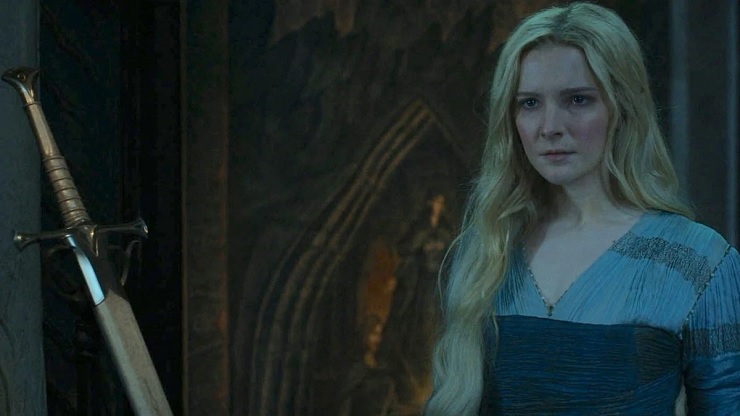
Episode 5, “Partings” — (Hoping that by “partings,” they don’t mean parting with all semblance of Tolkien lore.) The Hartfoots are migrating at last! The Stranger is helping out. Poppy sings a delightful song and we get an Indiana Jones–style map montage as they go. (They totally pass through Emyn Muil, east of Nen Hithoel and the Falls of Rauros. Heading towards future Mordor, it seems?) But following them are three mysterious cultists, who first appear at the Stranger’s landing crater. They are, according to the cast list, the Dweller (has a staff), the Nomad (wears a helm), and the Ascetic (carries a strange shield-like disc), and they sure do give off some sinister vibes. In the Southlands, Bronwyn tries to rally her people to resist when the orcs inevitably come calling, but Waldreg convinces a bunch of them to head out, choosing instead to swear fealty to the bad guys instead. Theo, fortunately, remains with his mom.
On Númenor, preparations are being made for the five ships and 500 soldiers being sent with Míriel and Galadriel. Isildur frets, wanting to go to Middle-earth, but his father, Elendil (who is going as a Sea Guard captain), refuses to pull any strings for his irresponsible son. Isildur’s sister, Eärien, is greatly dismayed by the mini-war that seems to be brewing. She tries to convince her new friend (boyfriend?) Kemen, Pharazôn’s son. Not easily done; Pharazôn is slick and masterful, not merely a dissenter to Míriel’s new direction but a man who sees a disturbing opportunity in helping the “low men” of Middle-earth. The seeds of imperialism are being planted.
Buy the Book
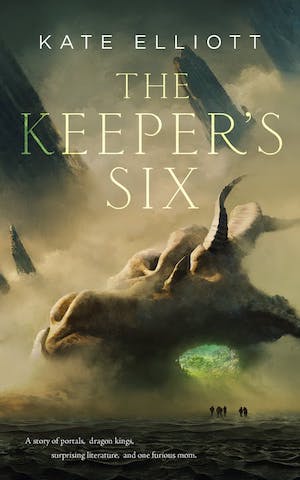

The Keeper’s Six
When the Hartfoots are attacked by three wolfish, lion-bodied creatures (not wargs, surely?), the Stranger throws down a bit of magic and repels them. The young men and women of Númenor engage in combat training because this close to the end of the island-kingdom’s power, evidently they’re not a strong military power yet. Galadriel schools some of the recruits, and Isildur’s friend Valandil gets a promotion. Tar-Palantir, up on his feet now, warns his daughter, Míriel, not to go to Middle-earth. There is only darkness there for her. While healing himself with frosty power, the Stranger inadvertently spooks Nori; now she’s not so sure he’s one of the good guys. Over in Lindon, at an elaborate outdoor dinner, High King Gil-galad acts like an asshole, and Durin holds his own (and scores a new table for Disa). Elrond tries to cool things down, but there is clear tension between the Dwarf prince and Elf king. Afterwards, Gil-galad lays it on thick with Elrond and gives him some troubling new exposition about a blight and a diminishing of the Elves. Whaaaa? And mithril is allegedly the result of a battle once fought between an Elf-warrior and a Balrog, and contains light from one of the lost Silmarils, which was allegedly inside a tree at the top of the Misty Mountains?
I say again: Whaaaa?
Isildur and Kemen run into each other in the hold of one of the five Middle-earth-bound ships; the former intends to stow away, the latter to be an arsonist. The resultant explosion (was that Saruman’s black powder in those kegs, or just liquor?!) destroys two ships. Isildur’s heroism in saving Kemen from the fiery wreckage earns him a spot at last. In Lindon, Celebrimbor reveals his part in Gil-galad’s puzzling deception. Elves now suddenly have a need for mithril? Yikes.
On Númenor, Galadriel works to convince a very reluctant Halbrand to join her in sailing back to Middle-earth and to claim his kingship. He speaks of some wrong he’s done that he does not wish to talk about, even as Waldreg in the Southlands and some of the villagers surrender to Adar. Adar demands the spilling of blood to cement this fealty, though we do not see it. But on the plus side, Theo comes clean about the scary vampire sword-hilt he’s got, and Arondir reveals an old sculpture in the watchtower that the Elves have apparently merely covered up. He says it’s possible this sword-hilt is actually a key and may have been used in the enslavement of the Southlanders’ ancestors. He works to pull Bronwyn back from despair, for she fears that surrendering is the only chance for survival. Elrond and Durin talk again, and more of the truth comes out. Elrond shares with his friend the scoop about mithril, which he sure seems to believe. Durin accepts it with some humor. Back on Númenor, Halbrand accepts Galadriel’s invitation and everyone gathers to set sail at last. Only three ships are now pointing their bows to Middle-earth.
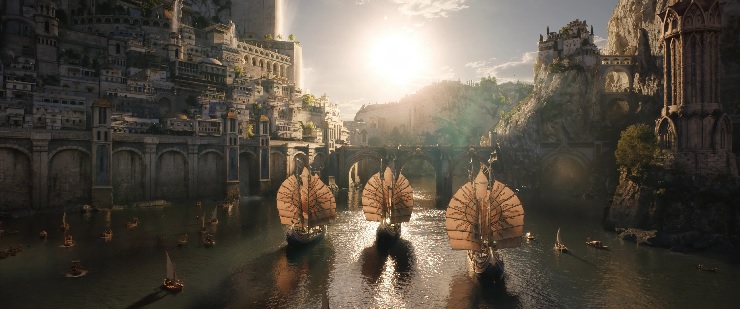
Three ships, instead of five. I wonder if that also means 300 people now? And just how many horses can fit onto three ships?
Anyway, that’s that. Now, let’s tackle the big issue. The mithril problem, which—it must be known to anyone new to Tolkien’s world—is absolutely not normally a problem. Mithril is legit, yes, but it’s just a rare and wonderful material worked into metal (so many cool Middle-earth artifacts are made of it, like Bilbo’s mail shirt and the helms of the Guards of the Citadel in Minas Tirith), and it’s even used to make ithilden, “that mirrors only starlight and moonlight,” which is essentially a special ink used on the West-gate of Moria and on Thror’s map of the Lonely Mountain, made to create moon letters.
In The Rings of Power, it’s suggested that mithril may contain light from “the lost Silmaril.” Now, first disclaimer: This is likely a total lie. A conspiracy tightly masked. A plot someone is plotting, whether it’s been concocted by Gil-galad directly or simply fed to him by someone else. Sauron is the obvious candidate there, wherever he is. But let’s proceed as if this claim were true. Even if it isn’t, it’s troublesome that beloved Tolkien characters like Gil-galad, Celebrimbor, and now Elrond all believe it. Hoodwinking Elves shouldn’t be this easy. Then again, these are RoPer Elves, and they’re quite different.
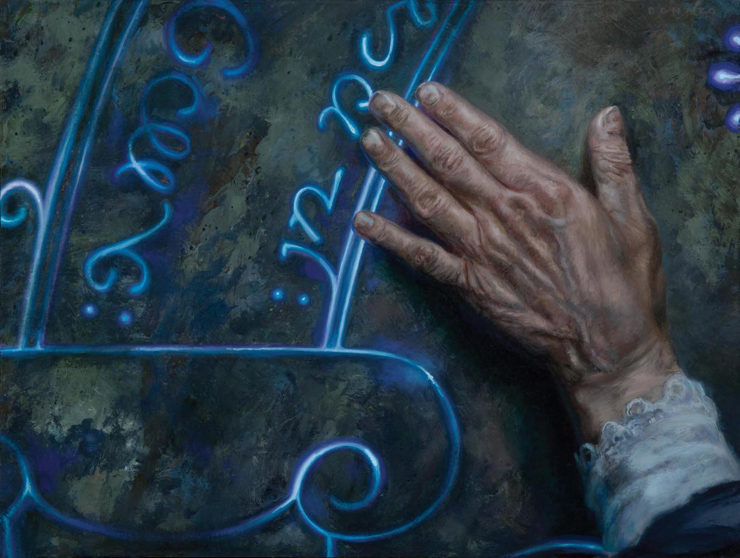
It must be remembered that The Lord of the Rings is the basis for this story, not The Silmarillion or Unfinished Tales or any of the other posthumously published masterpieces that casual viewers might consider mere ephemera. The Lord of the Rings is awesome but it doesn’t tell us much about the Silmarils. Mostly we just get that they were bright and beautiful jewels. They were sought after, stolen, reclaimed, and lost. As I explain in The Silmarillion Primer, much of the time the Silmarils are a kind of MacGuffin; even when they’re not physically present, they’re often discussed, yearned for, invoked, avoided, or even killed over. But though the stories of the First Age include scenes that demonstrate their actual power (usually in the actions of those handling them), there just isn’t much in the material Amazon has rights to. Which means Payne and McKay are forced to make up new things about them. Which will chafe book readers, yeah. Personally, I’d rather the Silmarils not be involved at all. They were a First Age thing. Why drag them into the Second?
In any case, Appendix A tells us that “with the power of the silmaril” Eärendil is able to pass the barriers that would otherwise have prevented his approach to Valinor, allowing him to call on the aid of the Valar to vanquish Morgoth. Then we get this nugget about them:
The silmarilli alone preserved the ancient light of the Two Trees of Valinor before Morgoth poisoned them; but the other two were lost at the end of the First Age.
I was at least was hoping The Rings of Power would stay true to the bit of lore they do have. We’re told the Silmarils alone preserved the ancient light of the Trees, not the Silmarils AND some special substance leaked into the mountain from the roots of a Silmaril-embedded tree. I suppose one could argue that this is something we, the reader, know truly, and that the loremasters of Middle-earth will know only in hindsight. Perhaps it’s feasible that the Elves could be fooled into thinking other things could preserve some of that Silmaril-light. And after all, Galadriel will one day place a bit of Eärendil’s light in her phial. That should be a big deal, shouldn’t it? Why bother with a phial of Eärendil’s light if Frodo’s mithril shirt’s already got some—ummm, let’s call it Silmithril—in it?
And the idea that Elves need this light to avoid perishing, like it’s some kind of inoculation? Ouch.
Anyway, so there are three Silmarils in total, and each imprisons some part of the long-lost light of the Two Trees. One of them, the Silmaril that was pried from Morgoth’s crown by Beren and Lúthien, eventually made its way to their granddaughter, Elwing, and passed from her to her husband, Eärendil. Eärendil now carries it as the Evening Star in his ship, which sails in the heavens for all in the world to see. (Never mind that in Bilbo’s song, Eärendil’s new ship was made of mithril and Elven-glass, and in the First Age, no less!) The other two Silmarils, per The Silmarillion, each end up somewhere unreachable by anyone. One was thrown into a fiery chasm deep within the earth, lost but not destroyed (the Silmarils are made of tougher stuff than even the One Ring), while the other was cast into the Sea by Maglor.
Now, the specific fates of those last two Silmarils are not addressed in The Lord of the Rings, so The Rings of Power can reinvent them. Thus, in episode 5, “Partings,” we’re told that in an obscure legend (the so-called Song of the Roots of Hithaeglir), the lost Silmaril (what, only one is lost?) somehow made its way inside a tree high in the Misty Mountains. And when some noble, pure-hearted Elf and a Balrog once battled one another over this tree, lightning got in on the fun. It “forged of their conflict” a new substance that apparently contains some of that Silmaril-light that was inside the tree.
My first question is: what became of the tree? Are we to believe that particular Silmaril was destroyed in the process, disseminated to become mithril?
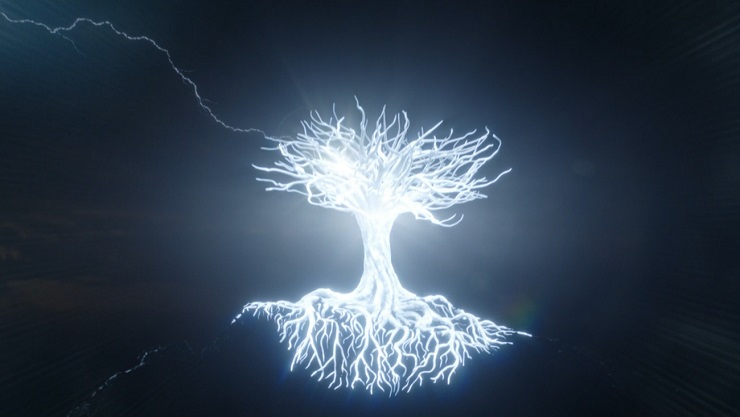
And now, for some reason, by spring of the current year (roughly six months away, given all the fall foliage we’ve been seeing), the Elves—all Elves everywhere still on Middle-earth?—need to be “saturated” in this, uhh, Silmithril light somehow or they will all fade into nothing? As Elrond explains to Durin, “Our immortal souls will dwindle into nothing, slowly diminishing, until we are but shadows swept away by the tides of time.” This fundamental change in the metaphysics of the Elves of Arda is probably the most absurd, if it’s true. It probably isn’t. I’m not super worried about that just yet, but it does seem like a drastic and far-fetched method by which Sauron is deceiving the Elves. Just how are all Elves meant to be saturated? Are Rings made of mithril able to somehow project that light upon all Elves in a certain radius? I’d love to see the specs!
So, do Elves diminish in Middle-earth? Yes, that’s canon in and of itself. But not like they’ve described. It’s a complex topic, but the decline of the Elves (and other peoples and creatures, to a lesser extent) is an omnipresent motif in the legendarium. I’ve talked about this before in “Tolkien’s Elves: How the Eldar Half Lives (and Lives, and Lives, and Lives).” But note, The Lord of the Rings itself doesn’t ever properly explain the fading of the Elven race, and since they can’t use The Silmarillion or scads of other books published by Christopher Tolkien after his father’s death, Payne and McKay may just be redefining what that could mean. Maybe. This whole arrangement might just be intended to seem shocking at this stage. To the Elves and to us, the viewers. We’re only on 5 of 50 episodes, though.
My concern is that this sudden desperate need to get so much mithril so fast is how Sauron is going to trick Celebrimbor and other Elven-smiths (if there are even any in The Rings of Power?) into forging all the Rings of Power. It’s a rather weak plot development, if this is so, particularly when compared to Tolkien’s own write-up of the situation (all too brief though it is). And yes, of course it mirrors Halbrand’s advice to Galadriel about identifying what it is your opponent most fears. In this case, there’s been no talk in the show about the Elves fading, so if this is Sauron’s scheme, it’s not something they already fear, it’s something he’s manufacturing for them to fear.
Anyway, so that’s the first bit of nonsense in episode 5, and the most drastic. The second bit is simply this idea that mithril contains Silmaril-light. It’s a bummer because mithril is already awesome all by itself. Mashing together two physical elements in the legendarium seems so unnecessary, and it undermines them both. I would be very curious to know what people unfamiliar with any of Tolkien’s books think of this new idea.
I’m not one to rate episodes or rank them, though. For all this, I rather enjoyed a lot of the scenes in both episodes. But if I had to make a Venn diagram of this show so far, it would be this.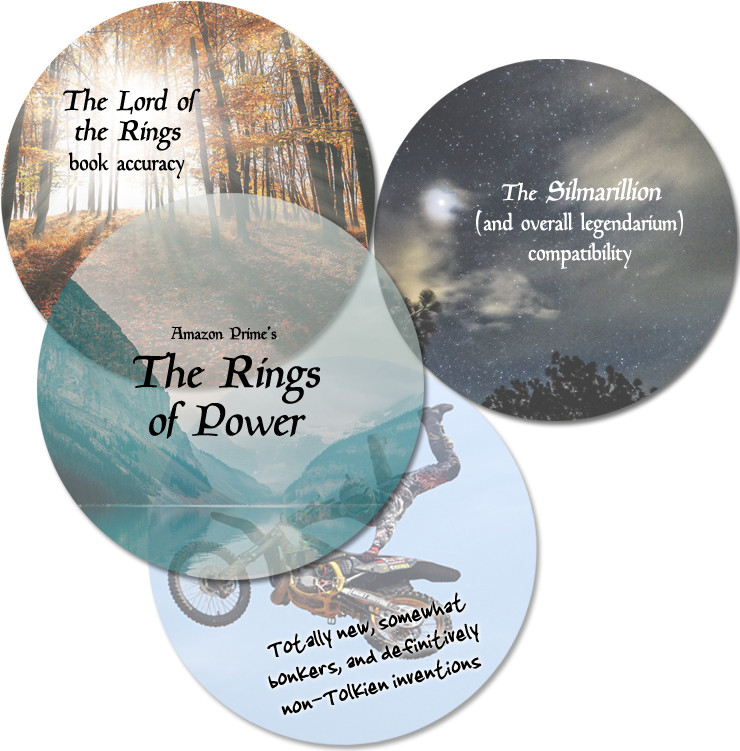
Now for some particulars.
Adar: Definitely a compromised Elf. Still not wild about that idea (since the few Elves who go this route in The Silmarillion are memorable for being few and well-written), but compared to the other plot choices, this now seems a small matter. He sure got riled up when Waldreg mistook him for Sauron, didn’t he? Touched a nerve. Is this a short-lived villain attempting to usurp Sauron, or just carrying out orders as some kind of lieutenant?
Arondir: Still good. Still the most Elf-like character in the show.
Bronwyn: At first I was thinking her role as a leader was too sudden, but she’s just got guts. Who else is stepping up to speak to her people? As Arondir is one of the most believable Elves, Bronwyn feels like a realistic depiction of a mortal woman. Terrified as any of us would be under the circumstance, courageous as a mother, and even willing to consider all options for survival.
Celebrimbor: For all Charles Edwards’ talent as an actor, I’m just not seeing the Elven-smith in him. To pull it off, I feel the show needs to show and not tell. I need to see him in an Elven-smock, with tools of the trade in hand, with smoke and vapors all around. He’s one of the Noldor; he should be industrious, not lounging about with mere props. I suppose it doesn’t help that his one outfit seems to resembles his chamber’s upholstery.
Círdan: Where the hell is he? I’ve heard we won’t see him until season 2. Fine, fine. It’s just weird to hear people talking about Eärendil as though they knew him, when it ought to be coming from Círdan the Shipwright, who was his close friend. Then again, RoPer Círdan could be very different from the faithful shore-dwelling old Elf we know and love from The Silmarillion. RoPer Círdan might act like a Brooklyn cabbie from an ’80s film and chomp on a cigar. (A círgar?)
Dialogue: As in the first three episodes, some of the dialogue is great, and some is just overwrought.
Disa: Even I would try mole-tail stew just because I wouldn’t want to make her sad. She seems such a charming host.
Durin IV: For all the bumpy spots of episode 5, Durin steals most scenes he’s in. He bristles with both emotion and cleverness. I love his trick on RoPer Gil-galad (I’m only sad that RoPer Gil-galad is someone we want to see knocked down a peg), and I love how he sets his feet on solid rock before prompting Elrond to speak the truth. So perfectly Dwarven.
Eärendil & Elwing: I’m grateful we got what we got, because I was half expecting no mention of the greatest mariner of song at all. But now that he does come up from time to time, he feels a bit mischaracterized. I haven’t liked Celebrimbor’s accounts of him. On the one hand, Eärendil was one of the Half-Elven, and effectively mortal until his final choice, and in that way I suppose it makes sense to hear of him more as a man and less as a myth from Elves who’d have known him. But Celebrimbor’s description of him still feels off somehow. “I heard your mother asking him, imploring him, why, why must it be him?” he says. And then I think of the tale, brief as it is in The Silmarillion, of Elwing casting herself into the sea to escape the treacherous sons of Fëanor, transforming into a sea bird by Ulmo, and delivering the Silmaril to her husband on his ship. Even Bilbo’s song in Rivendell, if it sings truthfully, gives her a better role than RoPer Celebrimbor paints.
There flying Elwing came to him,
and flame was in the darkness lit;
more bright than light of diamond
the fire upon her carcanet.
The Silmaril she bound on him
and crowned him with the living light
and dauntless then with burning brow
he turned his prow; and in the night
Eärendil and Elwing became a team, and it’s discouraging to see her downgraded in this way.
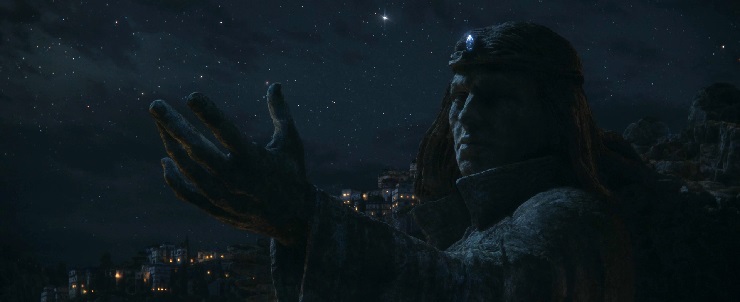
Elrond: I continue to appreciate RoPer Elrond, even though he’s been placed in such an awkward position in this story. It’s one thing that Celebrimbor is being played by someone (Sauron or whoever), because in the end the Rings of Power were an act of deception, but I wanted Elrond to be wiser to it all.
Eregion: Finally, we see some more people in Eregion. In the vast distance, just little figures standing around at the base of Celebrimbor’s under-construction tower. But I’m afraid for all its beauty, Eregion still looks so desolate.
Galadriel: Constantly contextualizing her, I’m still okay with RoPer Galadriel’s assertiveness. It’s starting to fit the truncated world of this show, and I’m still confident we’ll see an arc play out properly. That said, I think one of the things that grates on me is this focus on her pain and sorrow. I mean, it fits, yes. But why is she the only Elf who has such loss? She cannot have been the only one to lose nearly all of her family and friends in the wars with Morgoth. It’s the contrast with other Elves that makes her intensity stand out so much.
Gil-galad: I’m feeling bad for book Gil-galad, even though we get so little information about him. RoPer Gil-galad is deceptive, and that doesn’t become him or Tolkien’s world. The good guys might be careful how they word things, and they may hold back and speaks half-truths when necessary, but they so very rarely lie. It doesn’t feel right with the High King of the Noldor, who ought to have been the first one to see Sauron coming. Worse, book Gil-galad is famous for not treating with Sauron at all. Is Sauron already nearby, feeding him lies? And hey, what’s with Gil-galad not rolling the r when he says Galadriel’s name, like a proper Noldorin Elf? Maybe that’s our proof. But no, no, even Sauron would know how to do that right.
Halbrand: I feel nothing strongly about him, only a continual “All right, let’s see where they’re going with this, and why.” I don’t buy for a second that he’s Sauron, as many have guessed (and I guessed myself before seeing the first two episodes). Here’s my primary line of reasoning: In more than one scene between himself and Galadriel, she walks away, leaving him alone with his thoughts, his eyes introspective or even wet with not-quite-shed tears. There is no one looking at him in that moment, no one present to deceive with feigned emotion. Only we the viewers. I cannot imagine any such introspection or sorrow with Sauron. Future Nazgûl or Oathbreaker? Sure, why not? He’s still just a man.
Harfoots: In the landscape shot where we see the Brandyfoots’ wagon on the gray plains (the Braids, per the map), you can see the rest of the caravan camped further ahead. Yes, the Brandyfoots have been relegated to the back of their migration, but the Harfoots are not as cutthroat as many viewers are saying. When Malva says they should have taken their wheels, and you see Sadoc’s face, you can feel how shocking the idea is to simply abandon their own. The Harfoots have a rough life, but it’s not as extreme as all that.
But hey, honest question: Have I overlooked any mention of any other Harfoot communities beyond this one caravan?

Language: Have you noticed there are about thirty different languages you can choose between? Not just subtitles; audio dubbing. It’s amazing. I’ve watched episodes in both Italian and Spanish so my mother-in-law can watch, and even the voice acting seems pretty solid. And, oh man, Poppy’s song. “This Wandering Day” is performed in all of these languages. Some of them are just lovely. I’ve been toggling through them all just to hear the song in different voices and inflections.
Númenor: Two big facts jumped out in me in these last two episodes, consequences of the compressed timeline. Númenor isn’t very skilled in military matters yet (as represented by Galadriel’s street sparring session) and they’ve not gone imperial yet. Given Pharazôn’s opportunism, it’s clear they’ll head that way eventually, but I expect from a 2022 TV show they’re going to keep it rather watered down. In the books, Númenor became conquerors around 1800 of the Second Age, nearly a millennium and a half before Pharazôn’s time. They oppress the people in Middle-earth for a really long time and are second to none in military might; taking tribute and felling the forests of Eriador (to build their ships and fortresses) is what makes that region so empty. So RoPer Númenor is considerably weaker, and from the maps we’ve seen, Eriador is already less forested. In the long run, it seems like Númenor will do far less damage to anyone.
palantír: There is a section in Unfinished Tales that details the palantíri and how they work. And yes, I know The Rings of Power probably couldn’t use that information, so they’ll reinvent the powers of the palantír. Galadriel says, after witnessing “Númenor’s future,” as Míriel calls it, “Palantíri show many visions. Some that will never come to pass.” In this case, the Mirror of Galadriel that she will one day create is, what, a knock-off of this? The Seeing-stones were meant to communicate with one another, and had to be directed, steered. Now, is this particular palantír the Elendil Stone, the one that does work different than the rest, that looks west toward the Sea and the original Seeing-stone on Tol Eressëa? Maybe. It doesn’t matter so much.
But there is one aspect here that bothers me. They have this palantír showing not just some future, the sort of thing that the Valar could also predict. It’s the Númenórean Catastrophe, an event enacted by Ilúvatar himself. In the Akallabêth, when Ar-Pharazôn lands with his armies on the shores of Valinor, the Valar very specifically do not know what to do. They have no intention of fighting back, or attacking Númenor. It wasn’t their call to make. It’s above their pay grade. Manwë himself goes to Ilúvatar for counsel, and the Valar as a whole “lay down their government of Arda.” It is Eru Ilúvatar who does what was not foreseen, what no one saw coming (not even Mandos, the Vala who always seems to know more about what’s coming than anyone). The One sinks Númenor and changes the shape of the world. The idea that this catastrophe would be predicted by, or shown to, anyone feels like such a major lore break in and of itself. If Míriel sees it, and Galadriel sees it, then surely the Valar know about it, too, and now it’s not going to be much of a surprise. At that point, it becomes more of an open secret.
But this is a TV show, not the books, and the stakes do seem lower. I’m most curious now what it’ll be like for a character to carry around this foreknowledge of the drowning.
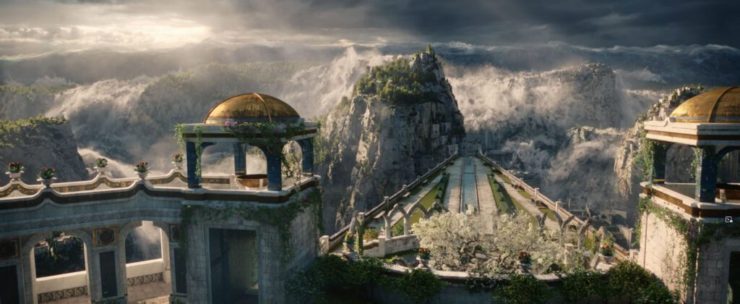
Pharazôn: Now it’s established that he is, in fact, cousin to Queen Regent Míriel. It remains to be seen whether he usurps the scepter by forced marriage or simply by popular support of his people, but I find that I don’t mind either way. I do find his willingness to adjust his plans with the changing of the tide fitting. Pharazôn seeks to master the current of Númenor, and that is sufficiently creepy. He’s playing the long game.
Schwwwinggg!: Halbrand’s newly forged sword blade makes the ringing sound of metal upon metal when he wipes it with a cloth. Hah!
Southlands, the Sword-hilt, and the Watchtower: So the Elf-occupied watchtower overlooking Tirharad and its environs had me wondering: Do Elves normally keep around evil relics and creepy statues of darker days? I guess RoPer Elves do. For posterity’s sake or the plot’s sake? Allowing vines to grow over the ol’ Sauron-and-sword statue seems to be the equivalent of sweeping dirt under the rug, no? Arondir knows—he’s not simply speculating—that the sword-hilt was a key to enslave the Southlanders, but he doesn’t seem to know if it’s a literal or metaphoric key. Many guess it has to do with igniting Orodruin, aka Mount Doom. Certainly the resultant sky pollution would be the best way to give the orcs some elbow room.
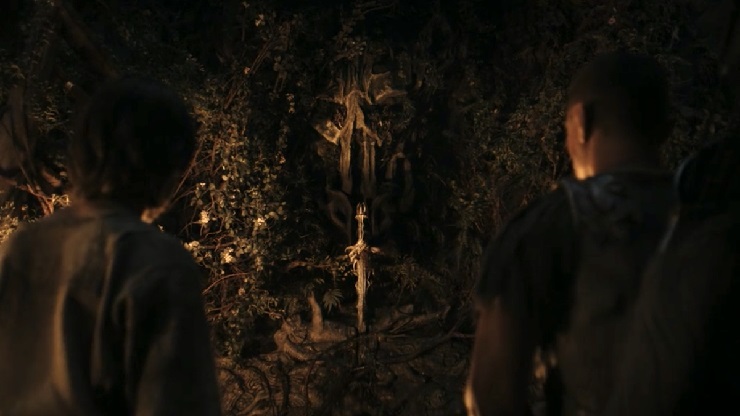
The Stranger: I suppose it’s possible that there’s still something sinister about the Stranger—though I’d say it’s around him, adjacent to him, not of him—but with every episode the idea of him somehow being Sauron becomes more absurd. During the travel montage, and Largo Brandyfoot is telling some story, the Stranger receives a cup with a faint smile, and it sure feels genuine as their “hearth” is shared with him. No one is looking at him there. Just us. He’s no enemy.
“This Wandering Day”: The lyrics are a puzzle, aren’t they? The song comes from Poppy’s mother, sings of “black sand, “eyes of pale fire,” and “the light in the tower.” Are these references to some experience known to Harfoots in the past or Harfoots in the future? Incidentally, per The Lord of the Rings prologue, the Wandering Days will be how hobbits refer to all the times before they settled in the Shire.
Time & Space: The Ring of Power is playing with Stars Wars timeframes, isn’t it? We never see anyone stop to sleep, nor anyone stopping to rest during any of the implied travel. The closest we get to camping and sleeping is with the Harfoots, but that’s their way of life. The fact that the characters seem to jump back and forth between Lindon and Eregion and Khazad-dûm doesn’t bother me half as much as not seeing a single shot of any of them on a horse, or in the company of guards or an escort, especially all these lords and princes. Will Disa’s new table be placed on some kind of Elf-wagon? Some things aren’t important to show, but the lands of Eriador and Rhovanion always seem so empty in the Third Age. Must they seem so in the Second? It would do wonders to show just a couple of travel shots for the Elves and Dwarves, if not montages. Not just because it would make the world seem a little more lived in, but because in Tolkien’s stories, the journey is the story. With the notable exception of the Harfoots, The Rings of Power is feeling like a series of set pieces.
Trees: There are a lot of trees coming up, as befits a Tolkien story. There’re the Two Trees destroyed in the prologue. There’s that tree Arondir was forced to cut down by the command of the orcs in an earlier episode. But I want to bring up two different trees relevant to episodes 4 and 5 above all. So we’ve been told there’s a blight on the Great Tree in Lindon, and Gil-galad admits they first took notice “just prior to Galadriel’s return.” (But he shipped her off anyway, ugh. #NotMyGilGalad) In any case, remember that the sapling in Durin and Disa’s home comes from the same tree, which Elrond described as “the very symbol of our people’s strength and vitality.” But I’m guessing this sapling has no such blight upon it, and I wonder if noticing that will end up being a clue with which Elrond Holmes can unravel the truth? If the tree in Lindon was somehow personally infected, à la Morgoth with the Two Trees of Valinor, then there’s no blight on the Elves at all, and it’s all just a ruse. Lastly, of course, there’s the tree in the Roots of Hithaeglir fable. Surely more of a symbol than a literal tree that once existed.
***
I’ll say again that I’m still enjoying the show. Yeah, I’m shaking my head at it more and more, but I’ve yet to throw up my hands and walk away. It would take a lot to break my ability to compartmentalize fairy tales. I suppose it’s because I still see the best in The Hobbit films, which most of my fellow Tolkien fans still gripe about even as they share images of Martin Freeman and the music of Howard Shore. So much good came from the trilogy, despite its many flaws, and after all these years not one page in my battered copies of The Hobbit has been stained by it.
Just the same, at any time, I can turn to “Of the Rings of Power and the Third Age” in The Silmarillion to remind myself how Tolkien envisioned Sauron’s movements in the middle of the Second Age, and read lines like:
Only to Lindon did he not come, for Gil-galad and Elrond doubted him and his fair-seeming, and though they knew not who in truth he was they would not admit him to that land.
With no mention of mithril or half-baked conspiracies about Elves with a definitive expiration date. And so everything’s fine. No need to panic. I look forward to the next episode, to see if they turn any of these new plot elements to the betterment of the story. Of this story, that is. All the same, it would be nice if they put away the J.J. Abrams mystery boxes by the end of season 1 and just concentrated on telling a good story.
Jeff LaSala is responsible for The Silmarillion Primer, the more recent and much shorter Second Age Primer, the Deep Delvings series, and a few other assorted articles on this site. Tolkien nerdom aside, Jeff wrote a Scribe Award–nominated D&D novel, produced some cyberpunk stories, and works in production for Macmillan and the Tor Publishing Group. He is sometimes on Twitter.










